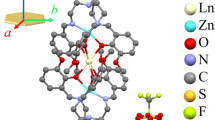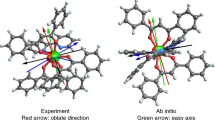Abstract
DURING the past few years, it has been shown that the diamagnetic susceptibilities of ions in crystals are approximately additive, and their values are in fairly close agreement with values calculated theoretically from the wave-mechanical structures of free ions1. Attempts to interpret the experimental results in more detail have been handicapped by a lack of essential data, for although results are now available for many substances, some have been obtained for solutions and others for crystals, and the two are not directly comparable. With the view of obtaining more precise information for a particular group of crystals, we have studied the susceptibilities of the alkaline halides, using a method of measurement previously described2.
This is a preview of subscription content, access via your institution
Access options
Subscribe to this journal
Receive 51 print issues and online access
$199.00 per year
only $3.90 per issue
Buy this article
- Purchase on Springer Link
- Instant access to full article PDF
Prices may be subject to local taxes which are calculated during checkout
Similar content being viewed by others
References
See E. C. Stoner, “Magnetism and Matter”, chap, ix (Methuen, 1934).
F. E. Hoare, Proc. Roy. Soc., A, 147, 88; 1934.
See L. Pauling, Z. Krist., 67, 377, 1928. W. Zachariasen, Z. Krist., 80, 137, 1931.
Author information
Authors and Affiliations
Rights and permissions
About this article
Cite this article
BRINDLEY, G., HOARE, F. Magnetic Measurement of Ionic Deformations in Crystals. Nature 135, 473–474 (1935). https://doi.org/10.1038/135473c0
Issue Date:
DOI: https://doi.org/10.1038/135473c0
Comments
By submitting a comment you agree to abide by our Terms and Community Guidelines. If you find something abusive or that does not comply with our terms or guidelines please flag it as inappropriate.



